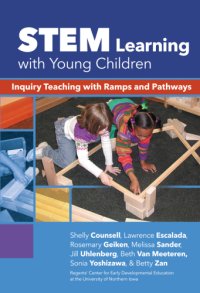
Ebook: STEM learning with young children: inquiry teaching with ramps and pathways
Author: Counsell Shelly, Escalada Lawrence, Geiken Rosemary
- Tags: STEM education, Science--Study and teaching (Early childhood), Instructional and educational works, Science -- Study and teaching (Early childhood)
- Series: Early childhood education series (Teachers College Press)
- Year: 2016
- Publisher: Teachers College Press
- City: New York;NY
- Language: English
- epub
Machine generated contents note: Introduction: Why STEM? Why Early Childhood? Why Now? / Betty Zan -- Definitions -- Why STEM? -- Why Early Childhood? -- Why Now? -- Organization of This Book -- 1. Why Use Ramps and Pathways? / Betty Zan -- Research and Theoretical Foundation for Ramps and Pathways -- The Inquiry Teaching Model -- Addressing Standards in Ramps and Pathways -- Conclusion -- 2. Implementing Ramps and Pathways in the Classroom / Sonia Yoshizawa -- Preparing the Environment for R & P -- Introducing Ramps to Children -- Teacher Intervention -- Appendix 2.1 Ramp Relationships -- Appendix 2.2 Using Questions -- 3. Physical Science Content and Inquiry / Lawrence Escalada -- What Is Science? -- Next Generation Science Standards and Research -- Physical Science and the Inquiry Teaching Model -- Science Process Skills -- Physical Science Content -- Conclusion -- Appendix 3.1 Definitions of Physical Science Terms -- 4. Ramps and Pathways Promote Communication Development / Beth Van Meeteren -- Communication Is a Central STEM Practice -- Conclusion -- 5. Using Ramps in Diverse Learning Communities / Melissa Sander -- Engaging Diverse Learners as Full Participants in Science Learning -- Creating Early Science Opportunities for Diverse Learners -- Accommodating Developmental Considerations During Science Activities -- Conclusion -- 6. Ramps and Pathways and STEM + Literacy / Beth Van Meeteren -- A Place for STEM in the Kindergarten and Primary Classroom -- A Sampling of Ramp Activity Challenges -- Building One-Piece Ramps: Various Heights -- Building One-Piece Ramps: Various Objects -- Building One-Piece Ramps: Various Spheres -- Connecting Ramp Sections -- Building a Ramp with a Jump or a Drop -- Using Multiple Pieces of Ramp Sections Within a Confined Area -- Building Ramps with Hills -- Building Within an Irregularly Shaped, Confined Area -- Building Vertical Ramps Within a Small Confined Area -- Building Ramps with a Fulcrum and Balance -- Mathematics Within Ramps and Pathways -- The Synergy of STEM and Literacy: A Personal Story -- Conclusion -- 7. Assessment / Jill Uhlenberg -- What Is Assessment? -- Types and/or Purposes of Assessment -- Research and Assessment -- Assessment and the Inquiry Teaching Model -- What to Assess -- How to Assess -- Conclusion -- Appendix 7.1 Ramps & Pathways Checklist -- Appendix 7.2 Observational Record: R & P Constructions -- Appendix 7.3 Learning Record: Engineering Behaviors -- Appendix 7.4 Learning Record: Science Content Knowledge -- Appendix 7.5 Engineering Habits of Mind Outcomes -- 8. Ramps and Pathways Professional Development: Creating Early STEM Communities of Practice / Shelly Counsell -- R & P Introductory Workshop -- Sustaining Professional Development Within Science Communities of Practice -- Sustaining Change.;This teacher's guide provides the background information, STEM concepts, and strategies needed to successfully implement an early STEM curriculum (Ramps and Pathways) with young children, ages 3-8. R&P actively engages young children in designing and building ramp structures using wooden cove molding, releasing marbles on the structures, and observing what happens. Children use logical-mathematical thinking and problem-solving skills as they explore science concepts related to motion, force, and energy.
Download the book STEM learning with young children: inquiry teaching with ramps and pathways for free or read online
Continue reading on any device:

Last viewed books
Related books
{related-news}
Comments (0)